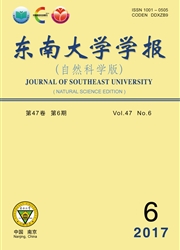

 中文摘要:
中文摘要:
针对预防血管支架植入后再狭窄的需求,分别用数值模拟和实验测试的方法研究了血管支架耦合系统的血流动力学因素.采用有限体积法的基于算子分裂的压力隐式算法进行了脉动流状态下的壁面剪应力分析,结果表明:壁面剪应力的最小值总是出现在支架杆临近区域;任意时刻,壁面某个点的壁面剪应力与入口速度、入口加速度正相关,壁面剪应力值低于0.5 Pa区域面积与入口速度负相关;在一个心动周期的部分时刻,支架段内出现低于0.5 Pa的壁面剪应力,因此该区域为内膜增生易发区;支架杆壁厚与低壁面剪应力区域面积正相关;支架杆宽度与壁面剪应力基本无关.采用电化学方法定量测试了在模拟血管内植入支架前与植入支架后的壁面剪应力平均值.结果表明:实验数据与数值分析结果具有较好的一致性,所提出的实验方法是对血流动力学模拟方法的合理补充和有效验证.
 英文摘要:
英文摘要:
In order to prevent the instent restenosis,the hemodynamics of the vessel-stent coupling systems is studied by combining numerical simulation methods with in vitro experiments.The pressure implicit with splitting of operators(PISO) algorithm of finite volume formulae is used to analyze the pulsatile flow of vessel-stent coupling models.The results show that,the lowest wall shear stress(WSS) always occurs at the area adjacent to each stent strut and links at any instants of the flow cycle.The WSS of certain points on the artery wall correlates positively with the inlet velocity and acceleration,while low WSS area of the whole artery wall has a negative correlation with the inlet velocity.Low WSS values less than 0.5 Pa are found at some instants in stented regions,which may provide a source of endothelial stimulation propitious to restenosis.Stent thickness has a positive correlation with low WSS area,while stent width has little relevance to WSS.In addition,the electrochemical method is used to quantify the time-averaged WSS with and without the implantation of the independent designed stent in model vessel.Well consistency between numerical and experimental results denotes that the proposed experiment can verify the hemodynamic simulation.
 同期刊论文项目
同期刊论文项目
 同项目期刊论文
同项目期刊论文
 Numerical investigations of the mechanical properties of a braided nonvascular stent design using fi
Numerical investigations of the mechanical properties of a braided nonvascular stent design using fi 期刊信息
期刊信息
